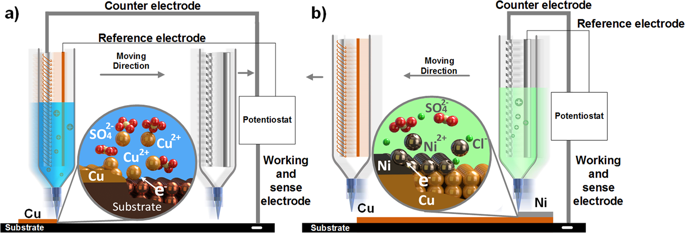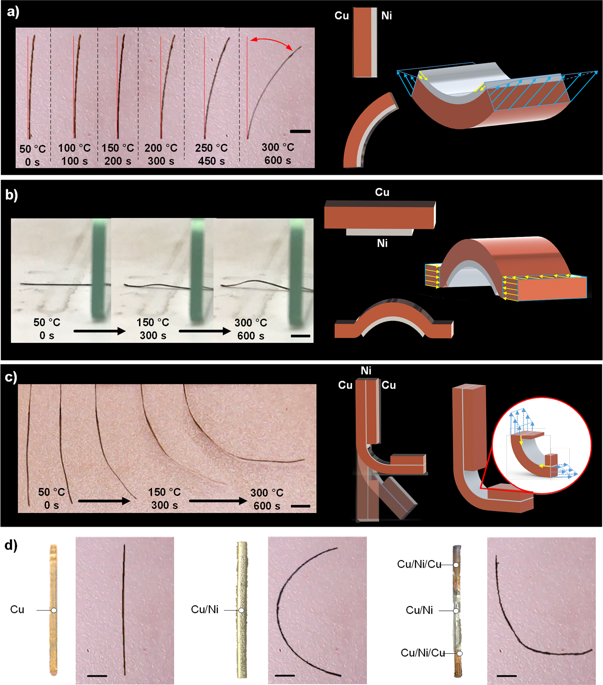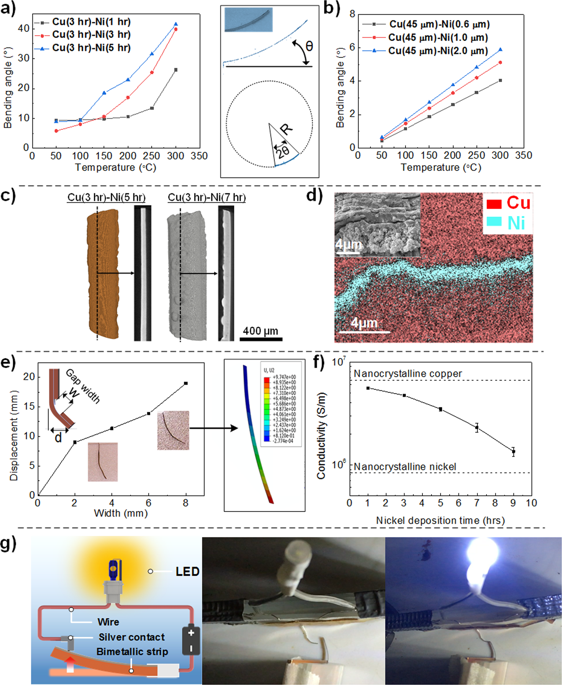3D printing involves countless different types of hardware, software, and materials. It is the perfect medium for continual experimentation—even into a different and more unknown realm like 4D. And once there, the whole cycle of experimentation and innovation begins again with different variables. In a recent study, ‘Multi-metal 4D printing with a desktop electrochemical 3D printer,’ by Xiaolong Chen, Xinhua Liu, Mengzheng Ouyang, Jingyi Chen, Oluwadamilola Taiwo, Yuhua Xia, Peter R. N. Childs, Nigel P. Brandon, and Billy Wu, metal materials are being experimented with, rather than the usual polymers.
The authors use a new technology with a multi-metal electrochemical 3D printer, making copper/nickel bimetallic parts that respond to temperature just like other self-assembling structures. Not only are they experimenting further on the 4D printing level, but with multiple types of materials—and in metal. As the authors point out, metal 3D printing can be cost-prohibitive for many users and businesses, and there are safety risks also, caused by exposure to laser, powder particles, and exceptionally high heat.
With electrochemical additive manufacturing (ECAM), metal parts are created by deposition of metal ions from electrolyte solutions. High temperatures are not required, safety is less of an issue, and the process is more affordable; however, speed is still a challenge. Adding multiple materials and the ability to self-assemble certainly expands the goals set in this study also.

Illustration of the low cost electrochemical multi-metal 3D printer. (a) Front view. (b) Print head setup. (c) Detailed view highlighting the deposition nozzles and the deposited bimetallic strip.
The authors outline numerous forays into 4D previously, from helical structures to corrugated parts. Hydrogen valves have been made in 4D, and other printed, ‘rigid’ objects have been made to morph via humidity. Almost all these items though have been unstable or fragile. In this study, the authors built on previous work, creating an affordable desktop electrochemical 3D printer with two nozzles from an older FDM printer, and experimenting with the following:
- Layer thickness
- Temperatures
- Deposition positions
“Further analysis into the metallic properties of the structures, such as, electrical conductivity and surface morphology is presented through scanning electron microscopy (SEM) and X-ray computed tomography (XCT),” state the researchers.
The team tested the copper bimetallic strips, paying close attention to their thermo-mechanical properties. The samples were put on a heated bed with only one end fully attached. A camera was set so the researchers could watch the samples deform as the heat increased.

Schematic illustration of the multi-material 3D printing process. (a) The meniscus confined copper electrodeposition process. (b) The meniscus confined nickel electrodeposition process.
“SEM imaging and EDS analysis showed that a tightly bound interface is formed between the copper and nickel layers, with printed lines exhibiting a convex cross section due to the higher reaction current density at the center of the nozzle. Optical microscopy during heating of various printed samples including Cu-Ni and Cu-Ni-Cu structures demonstrated the ability of the technique in creating different movements,” concluded the authors.
“The findings here thus present the first reported low cost, multi-metal 3D printing approach for creating high temperature 4D structures which opens the possibility for creating more intelligent structures and sensors.”

Thermo-mechanical response of different copper (3 h, 5 V vs Cu)-nickel Ni (5 hr, 2 V vs Ni) structures fabricated through a multi-nozzle ECAM approach. (a) Deformation of a Cu-Ni bimetallic strip with perpendicular heating. (b) Deformation of a Cu-Ni bimetallic strip with selective nickel deposition in the centre of the strip and heating with the strip flat against the heating bed. (c) Deformation of a Cu-Ni-Cu trilayer strip with Cu-Ni-Cu sandwich structures at both ends of the strip. (d) Optical images of samples programmed to exhibit the letters “ICL” at room temperature and 300 °C “ICL”. The scale bar is the same to all images in length of 2 mm.
Metal 3D printing is one of the most powerful types of fabrication today, whether in titanium, carbon, or more unusual forms like copper. Designers and engineers around the world are also delving further into 4D whether through fashion and consumer products, smart, industrial metamaterials, or shape-shifting epoxy parts. What do you think of this news? Let us know your thoughts! Join the discussion of this and other 3D printing topics at 3DPrintBoard.com.

(a) Measured bending angles for different Cu-Ni bimetallic strips at different temperatures. (b) Theoretical bending angles of Cu-Ni bimetallic strips with ideallised geometries. (c) XCT reconstructions of Cu(3 hr)-Ni(1 hr) and Cu(3 hr)-Ni(5 hr) samples with reconstructed cross-section images. (d) SEM micrograph and EDS mapping of the Cu-Ni-Cu interface. (e) Displacement measurements of trilayer strips with varying gap width along with validated FEA simulations. (f) Electrical conductivity measurements of the bimetallic strips. (g) Schematic and photos of a simple electrical circuit actuated by the printed bimetalic strip.
Subscribe to Our Email Newsletter
Stay up-to-date on all the latest news from the 3D printing industry and receive information and offers from third party vendors.
You May Also Like
3D Printing Unpeeled: Biofuel Waste to Filament & Sustainable Photopolymers
I can’t ever remember a day with so many potentially high impact news stories have come out. In one story, we all know that there are problems with the safety...
Finnair Hires AM Craft to 3D Print Plastic Parts for Aircraft Interiors
Riga-based AM Craft, a supplier specialized in 3D printing aviation components and certified under EASA Part 21G, announced a significant achievement today. The company will assist in upgrading Finnair’s A320...
3DPOD Episode 198: High Speed Sintering with Neil Hopkinson, VP of AM at Stratasys
Neil Hopkinson, a pioneering 3D printing researcher, played a pivotal role in developing a body of research that is widely utilized today. He also invented High Speed Sintering (HSS), also...
3D Printing Webinar and Event Roundup: May 12, 2024
Webinars and events are picking up in the AM industry this week! ASTM International continues its Professional Certificate Course and Stratasys continues its advanced in-person trainings, while 3D Systems is...
































